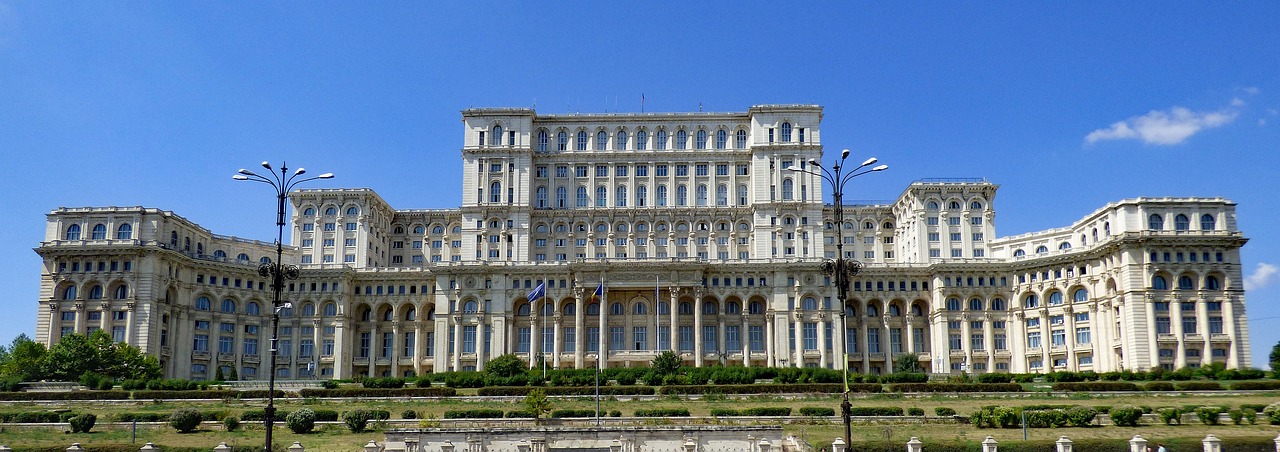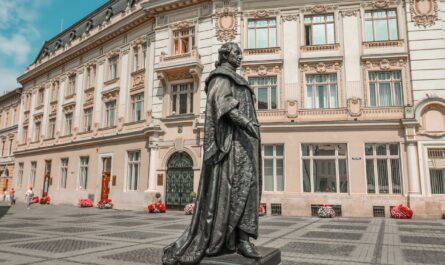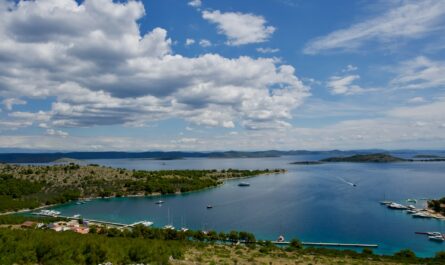Nestled in the heart of Eastern Europe, Bucharest stands as a testament to the rich history and diverse culture of Romania. Often referred to as the “Paris of the East,” this vibrant city is a captivating blend of the old and the new, where historic architecture coexists with modern structures, and traditional values meet contemporary lifestyles. Join us on a journey through Bucharest, exploring its fascinating contrasts that make it a truly unique destination.
Architectural Marvels:
Bucharest’s skyline tells a tale of centuries gone by and the city’s evolution through time. Begin your exploration in the Old Town, where narrow cobblestone streets wind around well-preserved 19th-century buildings. The architecture reflects a mix of influences, from French neoclassical to Ottoman styles, creating a charming and eclectic atmosphere.
Contrast this with the imposing communist-era structures like the Palace of the Parliament, the world’s heaviest building, showcasing the grandiosity of the Ceaușescu regime. The juxtaposition of these architectural styles mirrors Bucharest’s journey from a princely medieval town to a socialist republic and, eventually, a thriving modern capital.
Parks and Green Spaces:
Bucharest surprises visitors with its abundance of parks and green spaces, providing a refreshing contrast to the urban hustle. Herastrau Park, surrounding the expansive Herastrau Lake, is a popular spot for locals and tourists alike. The park offers a tranquil escape with walking trails, open-air cafes, and even a village museum, showcasing traditional Romanian village life.
In stark contrast, Carol Park, with its impressive Mausoleum and striking statues, bears the marks of the city’s communist past. Wander through the carefully manicured gardens, and you’ll sense the shift in atmosphere, from relaxation to a more solemn reflection on history.
Cultural Kaleidoscope:
Bucharest is a melting pot of cultures, and this diversity is evident in its vibrant arts and cultural scene. The city boasts a plethora of museums, galleries, and theaters, each contributing to the rich tapestry of Bucharest’s identity.
Visit the National Museum of Art to marvel at European masterpieces or explore the Museum of the Romanian Peasant to gain insights into the country’s rural heritage. The contrast between these institutions reflects the coexistence of artistic expressions ranging from the classical to the folkloric, showcasing Romania’s multifaceted cultural landscape.
Culinary Delights:
The gastronomic scene in Bucharest is as diverse as its architecture and culture. Traditional Romanian cuisine, with its hearty stews and savory pastries, shares the spotlight with a burgeoning foodie culture that embraces international flavors.
Indulge in a meal at Caru’ cu Bere, a historic beerhouse in the heart of the Old Town, where traditional Romanian dishes are served in a setting that transports you back in time. Then, venture into the trendy neighborhoods like Floreasca or Dorobanti to experience the modern and innovative culinary creations emerging in Bucharest’s contemporary dining scene.
Nightlife Extravaganza:
As the sun sets, Bucharest transforms into a nightlife hub that rivals some of Europe’s most famous party destinations. The city’s contrasting nightlife scene caters to diverse tastes, offering everything from laid-back pubs to pulsating clubs.
Head to Lipscani, the historic district, where you’ll find a plethora of bars and pubs. These venues, housed in centuries-old buildings, provide a cozy and intimate atmosphere, perfect for a relaxed evening. In contrast, venture into the trendy districts like the Floreasca or the Exarhia neighborhoods to experience the vibrant and modern clubbing scene, where international DJs and live music keep the energy high until the early hours.
Innovation and Technology Hub:
Bucharest has rapidly emerged as a key player in the technology and innovation sector, showcasing the city’s forward-thinking spirit. The contrast between the historic charm of the Old Town and the sleek, modern office buildings in the business districts highlights Bucharest’s journey into the digital age.
Visit TechHub Bucharest or explore the city’s growing number of co-working spaces, and you’ll witness the entrepreneurial spirit that is shaping Bucharest’s future. The city’s thriving startup scene is evidence of a dynamic and progressive mindset that coexists harmoniously with its rich historical legacy.
Local Markets vs. Modern Malls:
For a true taste of daily life in Bucharest, explore the local markets such as Piata Obor or Piata Dorobanti. Here, you’ll find fresh produce, traditional crafts, and the lively banter of local vendors, creating a sensory-rich experience deeply rooted in Romanian culture.
Contrast this with the modern shopping malls like Baneasa Shopping City or AFI Cotroceni, where international brands, upscale boutiques, and contemporary architecture converge to offer a cosmopolitan shopping experience. Bucharest’s shopping scene seamlessly blends the traditional with the modern, providing something for every shopper’s preference.
The Danube Delta Day Trip:
While not in the heart of Bucharest, a day trip to the Danube Delta presents a stark contrast to the city’s urban hustle. Just a few hours away, the Delta offers a serene escape into nature, with its intricate network of waterways, abundant wildlife, and unique ecosystems.
Embark on a boat trip through the delta, where the contrast between the city’s energy and the delta’s tranquility becomes strikingly apparent. Explore the untouched beauty of this UNESCO World Heritage Site and witness the diverse flora and fauna that thrive in this natural paradise.
Religious Diversity:
Bucharest’s religious landscape is another facet of its intriguing contrasts. The city is home to a multitude of churches and religious structures that span different architectural styles and historical periods. Start your exploration at the iconic Stavropoleos Church, a small yet ornate Orthodox church with intricate carvings that transport you to the 18th century.
Contrast this with the impressive St. Joseph Cathedral, a Neo-Romanian architectural masterpiece that reflects the city’s Catholic community. Bucharest also hosts synagogues and mosques, emphasizing the city’s religious diversity. This harmonious coexistence of various religious traditions showcases Bucharest as a melting pot where different faiths thrive side by side.
Street Art vs. Classical Sculptures:
Wander through the streets of Bucharest, and you’ll encounter a captivating interplay between classical sculptures and vibrant street art. The Old Town boasts statues paying homage to historical figures and events, contributing to the city’s rich cultural heritage.
In contrast, districts like Timpuri Noi and Floreasca showcase a burgeoning street art scene. Colorful murals and graffiti adorn building facades, providing a contemporary and urban aesthetic. This collision of classical and modern artistic expressions adds another layer to Bucharest’s multifaceted identity.
Thermal Springs in the Heart of the City:
Few European capitals can boast the presence of thermal springs within city limits, but Bucharest is home to the Therme Bucharest, a sprawling wellness complex. This modern facility combines thermal pools, saunas, and relaxation areas, creating a contrast against the backdrop of historical landmarks.
Indulge in a rejuvenating experience as you immerse yourself in the warm thermal waters, offering a unique juxtaposition between ancient wellness traditions and contemporary spa culture. Therme Bucharest exemplifies the city’s commitment to catering to diverse preferences, making it a destination that truly has something for everyone.
Educational Institutions and Historical Libraries:
Bucharest is not only a cultural hub but also a center for education and intellectual pursuits. The city is home to prestigious universities and libraries that bridge the gap between the past and the present. The Central University Library, with its neoclassical architecture, stands as a symbol of knowledge and heritage.
Contrast this with the modernist architecture of the Polytechnic University or the University of Bucharest, demonstrating the city’s commitment to educational innovation. Bucharest’s institutions of higher learning contribute to the city’s intellectual vibrancy, creating a contrast between the preservation of knowledge and the pursuit of cutting-edge research.
Transportation Evolution:
Bucharest’s transportation system serves as a testament to the city’s journey through time. Traverse the city by metro, and you’ll experience the efficiency of a modern subway system that seamlessly connects various neighborhoods. The contrast emerges when you explore the city’s historic tram network, with iconic yellow trams winding their way through the streets, offering a nostalgic charm reminiscent of bygone eras.
In addition to public transportation, witness the dichotomy of old and new on Bucharest’s streets, where horse-drawn carriages share space with sleek electric scooters. This juxtaposition reflects the city’s commitment to sustainable and contemporary modes of transportation while preserving the allure of traditional methods.
Seasons in the City:
Bucharest’s four distinct seasons bring a kaleidoscope of colors and experiences to the city. In spring, witness the rebirth of nature in Herastrau Park, adorned with blooming flowers and vibrant greenery. Summers bring a lively atmosphere to outdoor cafes and festivals, creating a stark contrast to the tranquility of winter, when snow blankets the city, transforming it into a winter wonderland.
Explore the Carol Park in autumn, where the changing foliage paints the city with warm hues, providing a picturesque backdrop to the historical monuments. The seasonal transitions in Bucharest add yet another layer of diversity to the city’s contrasting tapestry.
Community Markets and High-End Boutiques:
Bucharest’s markets not only showcase local produce but also highlight the thriving community spirit. Uncover the authenticity of places like Piata Matache or Piata Domenii, where vendors create a lively atmosphere with their fresh goods and friendly banter. Engage with locals and savor the flavors of traditional Romanian cuisine in these vibrant marketplaces.
Contrast this with the upscale boutiques and designer stores that line the streets of the city’s more affluent neighborhoods. Baneasa Shopping City and Promenada Mall cater to those seeking luxury brands and high-end fashion, embodying the city’s ability to cater to diverse economic and lifestyle preferences.
Festivals and Traditions:
Bucharest’s events calendar is a dynamic fusion of traditional festivals and contemporary celebrations. The annual Romanian Peasant’s Fair, held in the Village Museum, is a showcase of traditional crafts, music, and dance, offering a glimpse into the country’s rural heritage.
In stark contrast, the Bucharest International Film Festival and the Street Delivery Festival bring a modern and cosmopolitan flair to the city, celebrating international cinema and contemporary arts. The coexistence of these events underscores Bucharest’s commitment to preserving its roots while embracing global influences.
Conclusion
Bucharest’s status as Romania’s capital of contrasts extends into every facet of city life. From the evolution of transportation and the changing seasons to the dichotomy of community markets and high-end boutiques, the city continuously weaves together the old and the new. As you navigate through Bucharest’s streets, engage with its people, and immerse yourself in its diverse experiences, you’ll find that every corner reveals a captivating story of harmony amidst diversity—a city that embraces contrasts as an integral part of its identity.




